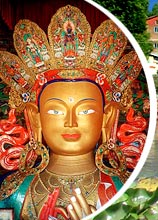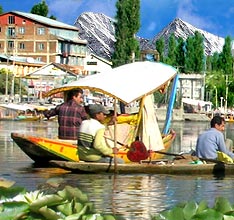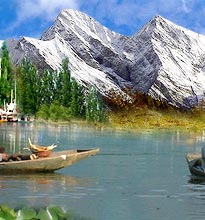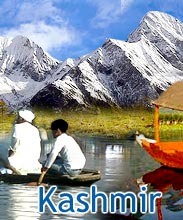 Leh
city, situated at a height of 3505 m, is the capital of Ladakh. Leh city
gained prominence under the rule of King Sengge Namgyal (17th century).
He shifted his court from Shey to Leh and the city became the regional
capital of Ladakh. Infact, the town's prosperity grew so much that it
became one of the busiest markets on the Silk Route. However, with the
closure of the Chinese border in 1950's, the city's prosperity came to a
sudden halt. But, after two wars in quick succession with Pakistan,
Leh's strategic value increased and reached a new high. Today, the army
soldiers and their families from the nearby military and air force bases
are the main support of the local economy, along with tourism.
Leh
city, situated at a height of 3505 m, is the capital of Ladakh. Leh city
gained prominence under the rule of King Sengge Namgyal (17th century).
He shifted his court from Shey to Leh and the city became the regional
capital of Ladakh. Infact, the town's prosperity grew so much that it
became one of the busiest markets on the Silk Route. However, with the
closure of the Chinese border in 1950's, the city's prosperity came to a
sudden halt. But, after two wars in quick succession with Pakistan,
Leh's strategic value increased and reached a new high. Today, the army
soldiers and their families from the nearby military and air force bases
are the main support of the local economy, along with tourism.Leh was opened to the foreign tourists in 1974. Since that point of time, there has no abatement in the influx of tourists. Infact, tourism in Leh Ladakh has been growing more and more day-by-day. The Leh city has doubled in size from what it actually was. Tourism in Leh holds many attractions for its visitors. The former Palace and Namgyal Tsemo Gompa, perched amid strings of prayer flags above the narrow dusty streets of the Old Quarter, are some of the places worth seeing in Leh. Then, there is the Sankar monastery adorned with modern Tantric murals and a thousand beaded Avalokitesvara/Avalokiteshvara deity. A short walk north across the fields of Leh serves as the perfect relaxant after getting stressed out from the hustle bustle of the daily hectic life. There are numerous other attractions of the city that charm tourists from far and wide.









